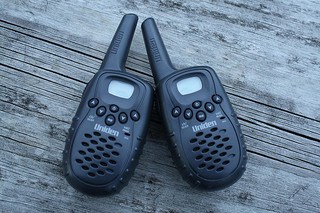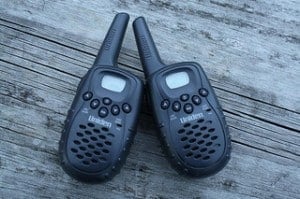Scout to base, scout to base. Have sighted flag on the oak tree by the stream. Over.
[…static…]
Roger scout. Sending reinforcements. Over.
[…static…]
— Walkie talkie conversation, suburban Ohio, circa 1993
My friends and I loved playing with walkie talkies. After all, we had really urgent messages to get across. Capture the Flag is serious business when you’re ten.
Besides the fun of using them, I found the walkie talkies themselves fascinating — playing with all the various buttons and settings, taking them apart and putting them back together (sometimes successfully). My favorite was the knob labeled “squelch” because I could turn it all the way down and get a really cool static noise.
In any electronic transmission, there is a certain level of background noise, which the receiver picks up alongside the signal. Modern electronics (your cell phone, for example) do this automatically or digitally, but on my walkie talkies, it was up to me. I had to “squelch” the weaker signals in order to hear important strategic updates about capturing the flag. Turn down the squelch, lots of static. Turn the squelch too high, no sound at all. The trick was to find the sweet spot when all the static was gone but the sound wasn’t entirely muted — in other words, the spot where the signal to noise ratio was greater than one.
A few days ago, without having to mess with a squelch knob, I heard Dave Davies interviewing Nate Silver on NPR about his new book, The Signal and the Noise. Why, you might ask, is NPR interviewing a statistician, even a (relatively) famous one? Because he spends his time sorting through the various election polling data and unearthing a signal from the noise of seemingly contradictory polls at his blog 538 (the total number of votes in the electoral college).
The election season has thrown a dizzying amount of information into public discussion. Writing from Ohio, election ground zero, every other commercial is a political advertisement. One thing I remember from playing with the squelch knob as a kid: the static was cool … for about 10 seconds until it became annoying and oppressive.
Election noise is even more oppressive than squealing walkie talkies. The signal the election needs to get across is far more important than even the most epic game of Capture the Flag, a signal about the direction of the nation and the kind of society we’re going to build with each other. Unfortunately, I can’t seem to find the sweet spot that separates the noise from the signal. I suspect it’s because there’s precious little signal going around. Over.



